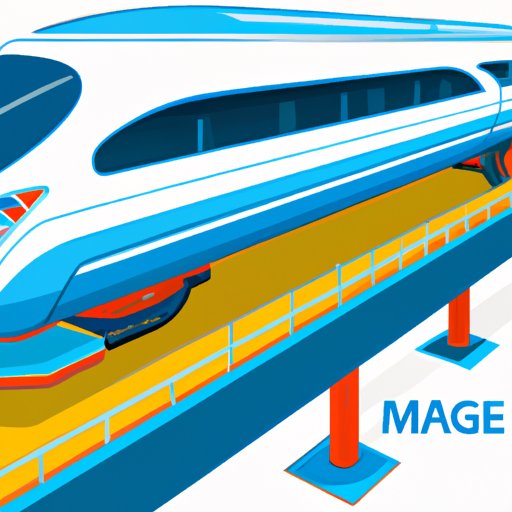Introduction
Magnetic trains, or maglev, are a form of transportation that use magnets to achieve a frictionless, efficient ride. These trains use magnetic fields to propel them forward and suspend them in midair, allowing for speeds up to 500 km/h. In this article, we will explore the technology and science behind magnetic trains, how they work, and the advantages and challenges of this revolutionary form of transportation.

Exploring the Technology Behind Magnetic Trains
Magnetic levitation is the technology behind maglev trains. This technology works by using strong magnetic fields to create a cushion of air between the train and its tracks. This cushion of air eliminates the friction between the train and the track, allowing it to move at much higher speeds than traditional railway systems. The magnetic fields also allow the train to be suspended in midair, which reduces wear and tear on the tracks and makes for a smoother, quieter ride.
The mechanics of magnetic trains involve using powerful electromagnets to generate the necessary magnetic fields. Onboard the train, superconducting magnets are used to create a stable field of repulsion between the train and the track. As the train moves along the track, the magnets generate an opposing force that keeps the train suspended in midair. This suspension allows the train to move faster and more efficiently than traditional railway systems.
Investigating the Science Behind Maglev Trains
The physics behind magnetic levitation is based on the laws of magnetism. Magnets have two poles: a north pole and south pole. When two magnets with opposite poles are placed near each other, they will attract each other; when two magnets with the same poles are placed near each other, they will repel each other. This phenomenon is known as the law of attraction and repulsion, and it is what enables maglev trains to float above their tracks.
In order to make a maglev train float, the magnets must generate enough lift to counteract the weight of the train. This is achieved by using superconducting magnets. Superconducting magnets are capable of generating extremely strong magnetic fields, which can create enough lift to keep the train suspended in midair. The magnets also generate a repulsive force that keeps the train from coming into contact with the track.
The laws of magnetism also explain why the train is able to travel at such high speeds. As the train moves along the track, the magnets generate an opposing force that pushes the train forward. This opposing force is stronger than the force of gravity, allowing the train to reach speeds of up to 500 km/h.
Understanding the Technology of Magnetic-Levitation Railway Systems
Maglev trains offer many advantages over traditional railway systems. For one, they are much faster and more efficient. They can reach speeds of up to 500 km/h, compared to the 200 km/h of traditional trains. This makes them ideal for long-distance travel, as they can get passengers to their destination much faster than traditional trains.
Another advantage of maglev trains is that they are much safer than traditional railway systems. Because the train is suspended in midair, there is no risk of derailment or collision. This makes them much safer for passengers, as well as reducing the cost of maintenance and repair.
However, there are some challenges associated with maglev train technology. One of the biggest challenges is the cost. Magnetic levitation technology is expensive to develop and maintain, and thus far it has only been used in a few countries. Additionally, the technology is still relatively new, so there are concerns about its long-term reliability.
Conclusion
Magnetic trains, or maglev, are a revolutionary form of transportation that use magnets to achieve a frictionless, efficient ride. This technology works by using strong magnetic fields to create a cushion of air between the train and its tracks, allowing it to move at much higher speeds than traditional railway systems. The physics behind magnetic levitation is based on the laws of magnetism, and the magnets generate enough lift to keep the train suspended in midair. Maglev trains offer many advantages over traditional railway systems, including speed, efficiency, and safety, but they are also expensive to develop and maintain. Despite the challenges, magnetic levitation technology is a promising form of transportation that could revolutionize the way we travel in the future.
(Note: Is this article not meeting your expectations? Do you have knowledge or insights to share? Unlock new opportunities and expand your reach by joining our authors team. Click Registration to join us and share your expertise with our readers.)
